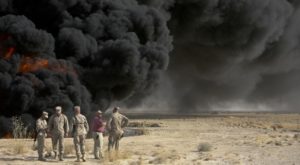Respiratory Symptoms from Burn Pits, Other Causes, Affect Many Veterans

Concerns about toxic exposures from military burn pits and other causes are getting more attention from Congress. Photo from May 26, 2019, VAntage Point blog.
WASHINGTON — Government medical agencies need to view toxic exposure as a high-priority issue deserving of specialized centers for research and monitoring, according to advocates who raised concerns that veterans with conditions related to their exposure to burn pits and other toxic substances might be left waiting decades for the science to catch up to their healthcare and benefits needs.
In the meantime, Congress or VA should consider making a presumptive service connection between some conditions and that veteran’s proximity to toxic substances, according to the argument made at a congressional hearing last month.
Anthony Szema, MD, a pulmonologist and director of the International Center of Excellence in Deployment Health and Medical Geosciences, testified to the Senate VA committee last month that respiratory problems are especially common among veterans serving near burn pits.
“The 2003 invasion of Iraq and resulting conflicts in the Middle East have led to the longest, prolonged military deployment in U.S. history. One million troops have served in Iraq and Afghanistan during the 18-year conflict,” Szema declared. “Now 26% of the 150,000 military personnel in the VA Burn Pits Registry self-report new onset respiratory symptoms. We noted 14.5% of New York-based soldiers developed new onset asthma, post-deployment.”
While some respiratory illnesses can be linked to dust, pollen, mold and even to proximity to explosions, the biggest risk factor is proximity to burn pits.
“Burn pits burn at low heat, generating more particles than incinerators. More particles are associated with increased all-cause mortality or death, cardiovascular diseases such as heart attacks and strokes, and lung diseases like asthma and COPD,” Szema pointed out. “Among these soldiers we have seen constrictive bronchiolitis and lung scarring or fibrosis. We can detect burn particles in the lungs of these troops.”
Centers Outside VA
The first step in better understanding how burn pits impact health is to create centers of excellence that can not only track the progress of veterans exposed to burn pits but also can perform original research on the conditions that might result from that exposure, he noted, adding that the best place for those centers might not necessarily be at the VA.
“We propose NIH or [the National Institute for Occupational Safety and Health]-funded monitoring centers for affected patients analogous to World Trade Center Monitoring Programs,” Szema explained. “In the greater New York area, for instance, most veterans are not seen in the VA, since they exceed income limits, are young with civilian jobs and have commercial health insurance. We envision centers studying basic animal models, investigating therapeutic agents, clinically monitoring patients and conducting clinical trials. The consultative National VA War-Related Illness and Injury Centers are few, and neither monitor patients nor perform biopsies.”
This kind of center would not be able to fill in all of the knowledge gaps when it comes to the impact of burn pits on soldiers, however, Szema suggested, because some of the gaps in research involve the need for better understanding of a servicemember’s health prior to deployment.
“Military personnel often do not have predeployment lung testing other than a 2-mile run time,” Szema explained. “If a soldier returns with a cardiopulmonary exercise test that is 80% post-deployment, that would be considered within normal limits. However, if predeployment she or he was 120%, then this is a significant decrease.”
During the last congressional session, bills were introduced in both houses that targeted burn pit exposure and veterans’ benefits. While those did not make it through their various committees before the end of the session, at least one has already been reintroduced this year—The Veterans Burn Pits Exposure Recognition Act. The bill would formally recognize that veterans who served near burn pits in Iraq, Afghanistan and elsewhere were exposed to airborne hazards.
Co-sponsors Sen. Dan Sullivan (R-AK) and Sen. Joe Manchin (D-WV), both members of the Senate VA committee, have stressed that the bill does not create a presumption of service connection.
“The decisions on presumption of service connection will require further scientific study and evidence, much of which is ongoing,” the legislators explained in a press release. “Even with a concession of exposure, veterans will still need to provide sufficient evidence of a link to a specific illness or disease in order to qualify for VA benefits.”
Some veterans’ advocates argued that the timeline for that science has historically been far too long and that Congress or VA should move to establish service connection to diseases related to toxins now.
“Many of the illnesses and diseases due to these exposures may not be identified for years, even decades, after veterans have completed their service,” explained Shane Liermann, legislative director of the Disabled American Veterans. “This is compound by the time it takes for VA to concede these exposures and scientifically associate presumptive diseases. In some instances it has taken decades to provide these veterans access to the benefits and healthcare they have earned. It’s been over 50 years since the end of [Vietnam], and [veterans] are still fighting for the inclusion of presumptive diseases.”
In lieu of establishing service connection for diseases, the best and most immediate step Congress can take is pass The Veterans Burn Pits Exposure Recognition Act, he added.
“If we take this idea of the concession of exposure and implement it now, it doesn’t require science,” Liermann said. “It doesn’t require anything additional. It’s a quicker service path for direct service connection for veterans.”


